The forecast predicts one of the hottest days on record for Victoria; temperatures of up to 43 degrees. What a lovely day for a dressage clinic – not! So I am making my way to Yarra Junction to Adam Wootten’s Australian Sporting Equine Academy, very early in the morning. Most lessons are scheduled before lunchtime, this should help with the heat.
Gary Lung is returning to Victoria for a two-day clinic, organised by Peta Elstrek who has arranged lessons with Gary ever since she witnessed his performance in the Mitavite Ultimate Masterclass in 2012. Most riders today are ‘repeat offenders’; one rider is here for her fifth (!) clinic with Gary. The polite and kind man who hails from PNG has many friends, in fact more than 2,200 on his Facebook page alone. And it comes as no surprise, Gary teaches his students in a quiet and positive manner, using simple terminology and plenty of colourful examples to make sure his pupils understand the exercise. “Squeeze his wither like a pimple” is the recommendation for Narelle Walker and Ego Centrepiece. The black gelding has just come back into work after a break and Gary makes them do plenty of exercise to get Centepiece’s back supple. “Don’t address the front, the back is the issue,” Gary directs. “When you soften, don’t let the reins go altogether. Tap him a little on the shoulder, don’t encourage him to lean.”
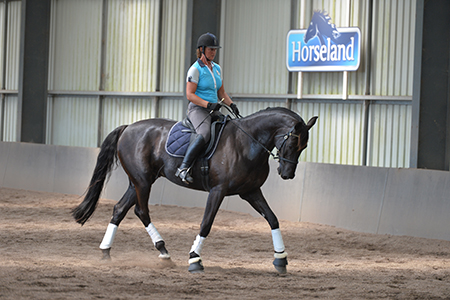
Narelle and Ego Centrepiece, working on suppleness
And after the lesson, “Did you feel that he was starting to move up? You did that by simply moving his body.” Narelle nods and beams happily.
Indeed every rider leaves the arena with a smile on his or her face, tired yes, but with a sense of achievement. Gary shows them exercises and movements that they can train and repeat at home. With every horse and rider, lessons are about moving the horse’s body, lots of quarters in, quarters out, leg yield, half-halts and transitions.
He calls it his ‘toolbox’. “It’s all very simple stuff”, Taylah Lambert says after her lesson, “But it works well, I find a massive improvement after each lesson.”
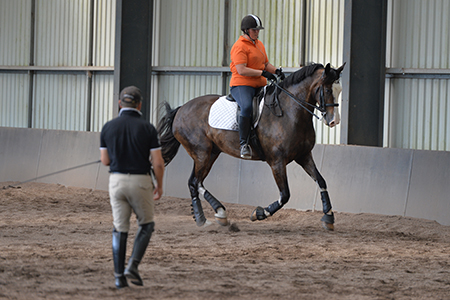
Sharyn and Flash are regular guests at Gary’s clinics
The indoor arena resembles a sauna by mid-morning, but Gary shows no sign of distress, he happily goes on and every rider gets the same attention and support during their lessons. Sharyn Symonds and her 17 hh Clydie/TB cross work on transitions and towards perfecting their simple change. Under Gary’s tutelage the pair has already progressed through the Adult Rider levels.
“Tell me, and think about this, what has made sense and what has worked?” Gary questions Marley Kerford. His youngest pupil today is only 14 years old and she has her hands full with her big paint, Junior, who is taking advantage of his young pilot.
“Last time we worked on movement, now we want quality of movement”, Gary continues. “He’s got that shuffling trot, he is like a wheelbarrow and he needs to become a motorbike. He needs to sit up, use his hindquarters and not fall on the forehand.” To demonstrate his point, Gary is quick to change into this top boots and jump on Junior himself to show Marley what the horse’s frame should look like. Gary puts Junior through his paces – leg yield in walk, then trot and canter transitions, a quick rein back when the gelding leans on the bit, yet a quick pat when Junior gives.
Gary provides a running commentary while he works on Junior’s suppleness, “Now he is light, he has to learn to do the work himself. When he leans on you, use your body, not your hand. Tell him he has to carry his own fat head.” Gary grins and hops off the horse, “Fun to ride,” he adds and then it is time for Marley again to show that she has understood.
“We stay so focussed on keeping the horse’s neck down, we forget about the rest of the body,” Gary states, “It’s all about straightness.”
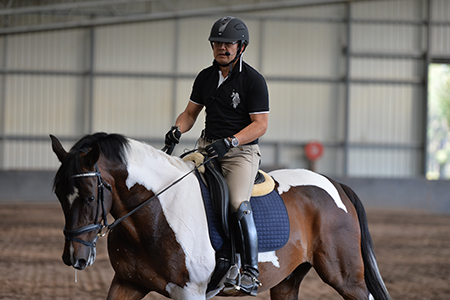
Gary doesn’t mind getting in the saddle to show what he means
Next up are four-star eventer Adam Benson and his elegant 17 hh grey Warmblood gelding, Revelwood Marmaduke. “His canter is fantastic, but he is a bit spooky and I want to take it slow,” Adam explains. Gary starts the pair on a circle and describes the ‘inside leg – outside hand’ principle to his audience. “Every instructor always says ‘inside leg, outside hand’ but never elaborates what it means. Treat it like a two-stage principle. Before you use the inside leg to push to the outside hand, you put a stage in beforehand, stage 1, and that’s actually showing them the outside rein. So bending them to the outside first. If you are going to the right, you flex them to the left. Once you do that and they click on the left side, they give to the left hand side, then you come with the inside leg – stage 2. That way you are actually creating ribcage bend, but you’re also bringing the back, the wither up and the frame up. You get them to work through their body. You can do that in the walk, trot and canter for every horse. It encourages them to use their body, especially their neck and shoulder, and step up from the inside hind to the outside hand.”
“Now test him, this is what Steffen always says, you go for five metres and then you test them. None of this letting them go on and on for 20 metres or more. Test him again, bring him back and let’s come to stage 2. Gradually bring in the inside leg, you might even bring the quarters out a bit, yes, that worked well, he curled like a banana shape around your leg. Go large again, good, change rein and do a little ‘quarters in’ on the long side. Slow it down, outside leg, good, and again. Even though you do quarters in, straighten him, don’t let him curl to the outside hand.”
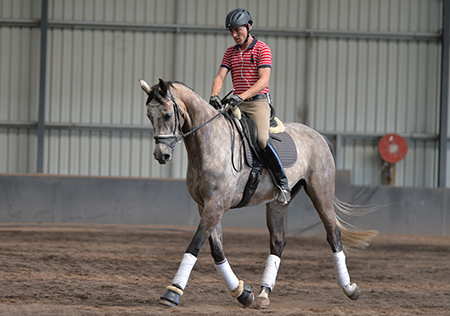
Adam has a promising young horse in Marmaduke
Marmaduke responds well and soon starts to swing in the trot. Gary has spent lots of time with Steffen Peters in the US and is now keen to share his experiences and Steffen’s training methods with his students. There is for example, the ‘box principle’.
“Steffen doesn’t accommodate horses all the time, rather he shows them. He says ‘put them in a box, this is the way we want you to go’, and leaves them and lets them develop within that box. When they step out of the box and they fall apart, you correct them, put them back in the box and leave them alone. None of the constant ‘nagging, nagging’, trying to tell them to do this and that. He is very much about putting them in this situation, and then with his help, gets them to work it out. He encourages them to learn by themselves instead of cranking and spanking and pulling them, or forcing them into this frame. You only correct it when they step out of the box. Initially when I used to get off Chester, I felt like I had ridden four horses, because I was constantly working. But now working with this system, I get off Chester and I feel like riding another ten horses, because the horse does the work, you guide them. You preserve your energy.”
Gary always adds his own style though. When one female rider curls up her body in the canter work, Gary has the following advice, “ Come on, sit straight, shoulders back and stick your boobs up, think D-Cup!”
With Gary Lung dressage work is as much fun and enjoyment as it is constructive.
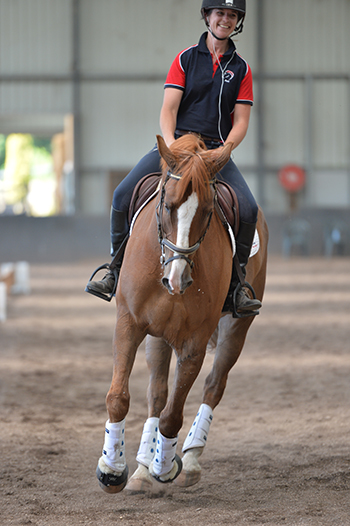
Gary’s lessons end with a smile – Peta and Jack
The Riders
Peta Elstrek & Tullows Jumpin Jack Flash
Peta had the 5-year-old since he was a yearling and is currently competing him at dressage level 3 HRCAV. Her goal today is for Jack to become softer, relax more over the back and bend through the ribcage for an even and consistent contact.
Marley Kerford & Junior
The slender young girl and her horse have her 2014 season mapped out, she is qualified for the Pony Club State Champs, then the Equestrian Victoria Young Rider competition in April and Interschools in July.
Sharyn Symonds & Alderbaran Admeyer
Sharyn and “Flash” paid attention to Gary’s words and won their next competition on the following weekend with 71.86%.
Adam Benson & Revelwood Marmaduke
Adam has just taken over the ride on the 6-year-old Warmblood that was bred by Amanda and David Shoobridge. The leggy grey is by Magritte out of advanced dressage mare Kirrang Serendipity and was formerly ridden by Cassia Montgomery.
Narelle Walker & Ego Centrepiece
Narelle had the 10-year-old gelding for 2 ½ years and has taken him from entry level to one star eventing in that time. Her goal for 2014 is a start at the Melbourne 3DE in June.
Taylah Lambert and Centurion
Taylah has high hopes for this 4-year-old gelding, she wants to take him eventing but needs to improve his flatwork first. Centurion is bred for showjumping, he is a spitting image of his sire Centus and out of a Heartbreaker mare, bred by Oaks Sport Horses.
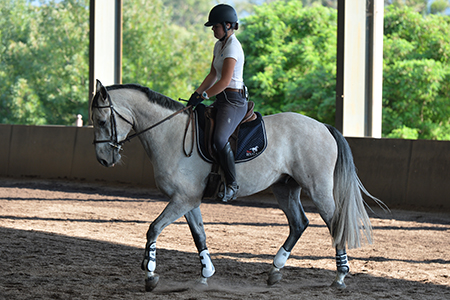
Taylah with Centurion
Gary, Steffen & Chester – an update
In the April 2013 issue of THM we published a big story on Gary Lung and his Weltmeyer gelding GB Winchester (Chester) and how the pair impressed US rider Steffen Peters so much, that Steffen suggested bringing the horse to his world-class stables in San Diego, for training. Gary and Chester travelled to Arroyo Del Mar for the start of what was to become a long and successful training partnership. Initially the horse was meant to stay with Steffen until November last year. I sit down with Gary to ask him what happened since that last article…
“I initially thought that Chester was going to benefit from this whole journey… but I think, if anything, I have benefitted the most out of this. I knew that I had to learn a lot more, and I knew that Steffen’s system was quite good. I liked what he had to offer and I liked the way he trained. But it’s not until you get there, that you realise, ‘crap’, I don’t know a lot! It’s changed my whole way of thinking; it’s about the straightness of the horse, there are no bells and whistles, it’s good classical training. And they work with every horse on an individual level. Like for example Chester had lacked in the collection and he was so bad in the straightness. They spend a lot of time straightening him up, that’s why he didn’t come back in November; he’s now coming back in April. Steffen spent the first three months teaching him about the collection, doing basic trot work, so it was quite an eye-opener. You realise how your training was not up to scratch. Only in the last six months they have started to ramp-up Chester’s training. He was doing all the FEI movements but wasn’t doing it in the FEI frame and FEI collection.”
“My whole riding style has changed. You can’t help it, when you have got five professionals in a barn (Steffen and his wife Shannon, Lientje Schueler and another couple, David and Rebecca), they are all around you, one will be teaching, one will be riding, one will be working with a young horse, one will be with clients; and all of them share the knowledge amongst them. They have the same problems that we have. Steffen is always there helping the others, Shannon is there, they often go, ‘try this, try that’, they are supporting each other, they watch each other. What do we do in Australia? We ride by ourselves. And what do we do when we ride by ourselves, not only do we not share, bad habits creep in and we don’t fix it. A lot more people in Australia are starting to work together, but we just don’t have the population at the moment and we have distances.”
“My plans are to go back to Steffen’s place in February and March. For me, it’s about going back and learning all the buttons, because I won’t have the luxury soon to pick up the phone and say ‘Lientje, Steffen, can you come and help me with this one?”
Are you almost a bit scared now that Chester is so fine-tuned?
“Yes, he’s so fine-tuned and they ride him so beautifully. A friend of mine said to me, ‘you got to remember Gary, you don’t ride like them. They are the world’s best, don’t compare yourself with them’. But you are concerned that now that they have done all this work, you don’t want to let Chester down. I am pretty much the one that’s behind the eight ball, I need to learn and come up to speed with it. I am planning to do a couple of shows over there, more as experience. It is nice doing shows over there, because you go as a ‘whole barn’. They set up these great marquees, you go a couple of days beforehand and do some schooling there, you either got Lientje or Steffen warming you up. I got to find the buttons and when I come back I will have to pretty much spend the year trying to consolidate everything.”
Sounds like you will have to familiarise yourself with your own horse again?
“Exactly. I go over there now and I get on him every six to eight weeks, but at home I am riding either young horses or problem horses. It takes me like a week to get in sync with him, Chester, and then in my mind I am still riding him like I did before. He’s a different horse now. Someone said to me, ‘it’s like you’ve gone and bought yourself a Grand Prix horse’.”
Does that make it more difficult than it used to be?
“I think so”, Gary laughs, “It would have been ideal if I went and spent six months training every day. Then Chester and I could have grown together. But because Steffen and Lientje trained him, he overtook me. Sometimes you can argue that is not a bad thing, it’s like having a schoolmaster, he’s got the buttons but you have got to learn where they are. Yet I have learned so much over there, and it’s not until you see them (Steffen, Shannon and Lientje) ride horses that you go ‘aha’. That’s the advantage. Visually watching someone makes it easier. Their system is clean and thorough; they spend a lot of time working on the quality of the paces. It’s not about riding movement after movement after movement. They are really pedantic. I often see Steffen just trotting around doing things, but you don’t actually know, what he is doing until you sit there and observe. But you can see that he is just fine-tuning everything, he is always about testing and fine-tuning. He doesn’t accept second-best. Young horses, he rides them very much in an uphill frame, a competition frame. I spent a lot of time working horses deep and round, long and low, and they do do that. They make their horses very supple, very loose, but they also teach them to come up into this competition frame really early in the work. They don’t hold them there for long periods, then they let them down again. So the idea is, you don’t work your horse at home long and low, and then take them out and put them up because the judge says so. You ride them in a competition frame at home, so it is not such a rude awakening and it develops their muscles and their strength. The opportunities I had of watching Steffen’s team ride their problem horses and how to fix it, has certainly helped me. And I have come back wanting to share this. In all the clinics that I am doing around the countryside, people have come back to me and said ‘your system is really easy’, its about good basic training. That’s what Steffen is all about, but also the Carl Hesters of the world. They are all about the quality of the work, not just making them fancy. If you do the right thing, the fancy will come.”
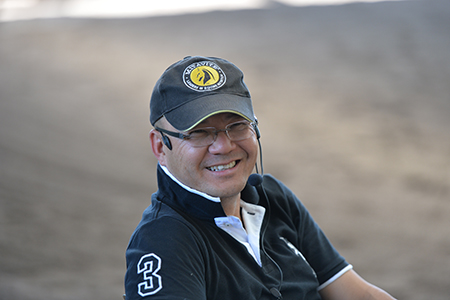
With all horses and riders today, you worked on getting them off the forehand, move the horse’s body…
“Which is very much one of the key things that I learned from Team Peters. None of their horses are encouraged to go on the forehand. I remember, the very first time I warmed Chester up, the second or third day I was there. Here I was, thinking I was ‘Christmas’, I was in Steffen Peter’s barn with Chester, I was flexing him and bending him and putting him deep and round… and Steffen stood there and then he stopped me and said, ‘what are you doing?’ I went, ‘I’m warming up my horse’. Steffen said, ‘why do you want to put it right down there? You are encouraging him to go on the forehand, he doesn’t need that. He needs to be compressed, and sitting on the hindleg, light in front.’ I went, ‘no, I’m not’, he went, ‘yes, you are’ and we had a little discussion.” Gary chuckles.
“Don’t get me wrong, they do loosen their horses, and they stretch them out and go long and low, but they teach them from day one, sit on the hindleg, lift up, on the bit. None of this ‘buried down on the forehand, round and round for half an hour’. By the time you pick them up, the horse is tired, the horse mentally thinks, this is the way I go, on the forehand. You warm up a little bit, but you pretty much say straight away, we want you up here. Yet you are not hooking them up, it’s about riding them up into the contact.”
“It is really, I want to say ‘warm and fuzzy’, a great feeling to learn, and I want to share it with others. I love it when people soak it up like a sponge! I know what it’s like to struggle to find a system that works for your horse. I found something that works well, no matter your level, and I want to share it. Before I went to America, my whole focus was about riding and competing. I still like competing, but I really now enjoy the training side. If someone said to me, ‘what is your goal?’ My goal is to be able to produce competent, confident horses to FEI level, to Grand Prix. I like the idea of taking a horse and working through what the horse has to offer, discover its personality, its traits and get the best out of it. When a horse can do something and it feels comfortable and relaxed, that motivates me. The trip to Steffen was a once in a lifetime opportunity. It’s given me a new sense of energy.”

Fantastic to read your story Gary. I was able to experience much of what you are saying in my very first clinic with you & can’t wait for more. Thanks